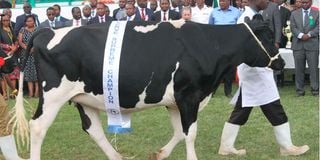How to protect your Friesian, Ayshire breeds attain their full production

A Friesian dairy cow in Eldoret. Milk from the breed is low in butter and fat.
What you need to know:
- Though the Friesian and Ayrshire are high milk producers, they rarely attain their full production potential in Kenya due to feed scarcity and poor knowledge of farmers on their husbandry.
The Friesian/Holstein breed of dairy cattle is the most common in Kenya, followed by Ayrshire. Both were introduced in the country in 1908. The two are the highest milk-yielding breeds, based on a lactation period of 305 days.
The Friesian was imported from the Netherlands but over time, it has been widely bred with semen from the rest of Europe, America and Israel. The Ayshire came from South Africa.
Other breeds of dairy cattle in Kenya are Guernsey and Jersey.
These are smaller than the first two but their milk has high butter fat content. The Guernsey was introduced in Kenya from the Guernsey Island in the 1930s.
The Jersey, on the other hand, came from Jersey Island off the coast of France in 1920.
Though the Friesian and Ayrshire are high milk producers, they rarely attain their full production potential in Kenya due to poor knowledge of farmers on their husbandry and feed scarcity.
The two have been heavily and indiscriminately crossed with other breeds so that most of the animals farmers call Friesians and Ayrshires are actually mixes of breeds.
I have noticed that the Friesian is slowly edging out other breeds in Kenya due to availability of the semen and the hype given to it as a high yielder.
However, it is good for farmers to understand that among the four breeds of dairy cattle, touted globally as good milk breeds, each has high and low points.
It is, therefore, important to make decisions on which breed to keep, based on what a farmer wants to achieve.
The Friesian cow is black and white but there is a red and white type that is estimated to be about one per cent of the breed population. People often confuse it with Ayrshire but its body form, weight, colour pattern and milk production distinguish it from the Ayrshire.
A mature Friesian female weighs 400 to 600kg and measures 1.5 to 1.8 metres at the withers, the highest point on the shoulders. It yields 3,000-8,000 litres of milk in 305 days with 3.1 to 3.8 per cent butter fat and 3.3- 3.6 per cent protein.
The breed matures for the first insemination at 15-18 months and gives its first calf at 24-27 months. It is a heavy feeder and requires high quality feed. It consumes 12-18kg dry matter of feed, equivalent to 34-54kg of wet feed daily.
Most farmers are not able to give such amounts of feed due to scarcity and lack of sufficient knowledge on cattle nutrition. That explains why most cattle are almost always in poor body condition.
While the Friesian is popular among farmers, production achieved in Kenya is about 1,500 to 2,000 litres of for a lactation period.
Farmers should, therefore, look for a breed that is less demanding but producing close to the realised Friesian production but using less feed and incurring less cost.
The Ayrshire comes next to the Friesian in body size, milk yield and preference by farmers.
The breed has a brown and white coat pattern almost in equal measure but some animals tend to be dark mahogany.
Ayrshires stand at 1.4-1.6 metres at the withers and adult females weigh 380-500kg.
The breed, therefore, eats close to the same quantity of feed daily as a Friesian. An Ayshire cow produces 3,000 to 6,000 litres of milk in a 305-day lactation period.
Again, these animals tend to under-produce due to poor and inadequate feeding. Ayrshires are ready for breeding at 15-18 months and give their first calf at 24-27 months.
The Jersey is the third most popular dairy breed locally. Its numbers have dwindled due to the heavy promotion of the Friesian.
However, as more people realise the downsides of the Friesian and the unfulfilled production potential, the Jersey appears to be making a comeback.
Jerseys have a light brown, grey or dull black colour in various mixes. They have a dished nose and characteristically protruding black eyes. They stand at 1.3 to 1.5 metres at the withers and the adult female weighs 250-350kg. The milk yield on 305-day lactation is 2,000 to 5,000 litres.
Jersey milk is high in butterfat at five to 6.5 per cent. I recall one consumer who once asked whether milk from her supplier, who reared Jerseys, had been expanded with cooking oil.
Jerseys are known to utilise less quality feed than Friesians and Ayrshires. The size and production data of the breed also means that Jerseys can produce the same amount of milk as Friesians on half the daily feed consumption.
In addition to low feed requirements, the breed matures for first service at 12-18 months, giving its first calf at 21 to 27 months. The combination of the low adult weight, low daily feed requirement, early breeding maturity and high butter fat content in milk makes the Jersey a good breed for farmers with feed scarcity.
It is for those qualities that a potential farmer from Somalia requested me in March to help him source 20 pregnant Jersey heifers for export to his country. I am still searching but that is a story for another day.
Finally, there is the Guernsey, whose utilisation in Kenya has declined to the extent that its semen is no longer being produced locally. Its attributes fall between the Ayrshire and Jersey in feed intake, milk quality and quantity and production cost.
The two dairy breeds we must seriously guard against decline are the Jersey and the Friesian; being on the opposite extremes of milk quality, quantity, feed input and cost of production.





